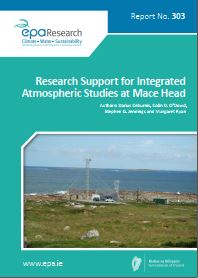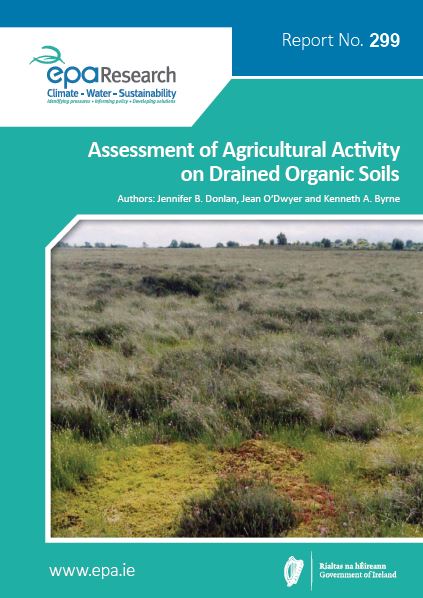
Authors: Stephen Barry and Bernadette O’Regan, April 2020
Year: 2020
Non-methane volatile organic compound (NMVOC) emissions from Solvent and Other Product Use have been estimated for 2006–2012. This included updating the activity data, emission factors and emissions data and compiling this information into a national emissions estimate for the specified years.

Authors: Laura Devaney, Diarmuid Torney, Pat Brereton and Martha Coleman, April 2020
Year: 2020
The Irish Citizens’ Assembly afforded 99 citizens the time, space and structure to deliberate on some of the most important issues facing Irish society and politics. The 13 climate recommendations agreed on by the citizens in consideration of “How the State can make Ireland a leader in tackling climate change” were significantly more radical than many expected. They encompassed a suite of sectors, solutions and policy actions.

Authors: Philip M. Perrin, Stephen Waldren, Marcin R. Penk and Fionnuala H. O’Neill , April 2020
Year: 2020
Coastal saltmarshes provide a range of important ecosystem services but face increasing challenges because of human activities. Ecological assessments of saltmarshes are required to inform reporting in compliance with the European Union (EU) Habitats Directive (HD) (92/43/EEC) and Water Framework Directive (WFD) (2000/60/EC).

Authors: Mary Kelly-Quinn, Michael Bruen, Mike Christie, Craig Bullock, Hugh Feeley, Edel Hannigan, Thibault Hallouin, Fiona Kelly, Ronan Matson and Ewa Siwicka, April 2020
Year: 2020
The ESManage project tested an eight-step methodological framework to help embed ecosystem services and the ecosystem services approach into policy and decision-making for the sustainable management of water resources, as required by the Water Framework Directive (WFD).

Authors: Niall Keely, Myles Kingston and Ken Stockil, April 2020
Year: 2020
The environmental compliance and enforcement landscape has evolved significantly over the last number of decades, with policy and legislation serving as a key driver. The nuances and complexities of compliance and enforcement have also evolved, as they now require a better understanding of the barriers and challenges, drivers and incentives, and the behavioural and contextual factors at play among regulated communities.

Authors: Jesko Zimmermann and Jane Stout, March 2020
Year: 2020
Land use and land use change have a significant impact on national greenhouse gas (GHG) emissions and are therefore an integral part of national GHG reporting, as laid out by the United Nations Framework Convention on Climate Change. In Ireland, land use and land use change reporting is currently based on total national agricultural area data provided by the Central Statistics Office.

Authors: Éva Ujaczki, Lisa O’Donoghue, Patricia Cusack, Mark Healy, Teresa Curtin and Ronan Courtney, March 2020
Year: 2020
The scope of the Al Source project is to determine the optimisation of state-of-the-art technologies that could offer potential in the reuse of bauxite residue to recover valuable elements.

Year: 2020
This infographic gives information about the EPA research programme in 2019

Authors: Paul Nolan and Alastair McKinstry , March 2020
Year: 2020
This report provides an overview of future global climate projections as simulated by the EC-Earth Earth system model. The global climate simulations described in this report constitute Ireland’s contribution to the Coupled Model Intercomparison Project (CMIP) (phase 6) (CMIP6) and will be included for assessment in the United Nations Intergovernmental Panel on Climate Change (IPCC) Sixth Assessment Report (AR6)

Authors: Martina Hayes, Aileen Callanan, Mairead Harding, Christopher Lynch and Francis Burke, February 2020
Year: 2020
The filling of teeth is one of the most routine and common tasks undertaken by dentists. Because of the availability of community fluoridation and improved dental care, Irish adults have fewer missing teeth; however, they have more teeth with fillings.

Authors: Ainhoa González, Riki Therivel, Antonia Gaughran and Craig Bullock, January 2020
Year: 2020
The SEA Directive aims to integrate environmental considerations into planning and decision- making, with a view to promoting sustainable development. However, the extent to which the findings of environmental assessments are informing decisions is not fully understood. This report presents the findings of the second review of Strategic Environmental Assessment (SEA) effectiveness in Ireland.
Year: 2020
This Discussion Document is the basis for the first phase of the Consultation Process where feedback / comments are sought on the proposed directions of the new EPA Research Strategy.

Authors: Stuart Green, Shafique Martin, Saeid Gharechelou, Fiona Cawkwell and Kevin Black, December 2019
Year: 2019
Hedgerows are an important feature of the Irish landscape. They perform multiple functions, acting as boundary markers, reservoirs of biodiversity, controlling run-off and they store carbon in above-ground biomass. The purpose of this study was to examine the use of an active remote sensing tool, imaging radar, to estimate biomass in hedgerows.

Authors: Mike G. Whitfield, Mohamed Abdalla, Giuseppe Benanti, William Burchill, Dru Marsh, Bruce Osborne, Brendan Roth, Matthew Saunders, Pete Smith and Mike Williams, December 2019
Year: 2019
This project was concerned with improving the national inventory of GHG emissions from Irish soils. The IPCC's Tier 2 and 3 methodologies were used, effectively upscaling regional data on N2O and CO2 to the national level, through a combined process-based model and geographic information system (GIS) approach.

Authors: Celine McInerney, Conor Hickey, Paul Deane, Joseph Curtin and Brian Ó Gallachóir, December 2019
Year: 2019
The European emissions reduction policy is clear and calls for the energy sectors, particularly the electricity sector, to be carbon neutral before 2050. The objective of this study is to examine how the decarbonisation of the power system will impact the investment case for both electricity generation and infrastructure assets.

Authors: Darius Ceburnis, Colin D. O’Dowd, Stephen G. Jennings and Margaret Ryan, December 2019
Year: 2019
This fellowship project supports extensive research efforts on particulate matter (PM) studies in Ireland and at Mace Head station, particularly for building a knowledge base and establishing and sustaining long-term measurement series at the station.

Authors: Justin Doran, Thomas McDermott, Paul Kilgarriff, Swenja Surminski and Mauricio Perez Alaniz, November 2019
Year: 2019
Climate change is likely to lead to physical changes in temperature and precipitation and sea level rise, and Ireland is already experiencing the effects of climate change on its weather patterns. This project identifies several interacting factors that should be considered in designing efficient climate change adaptation strategies.

Authors: Eileen Culloty, Alan Smeaton, Jane Suiter, Padraig Murphy, Pat Brereton, Dian Zhang and Dave Robbins , November 2019
Year: 2019
Research indicates that public concern about climate change is largely derived from media consumption. This project investigated coverage trends on climate change across print, broadcast and online media in order to make recommendations for climate change communicators.

Authors: Eileen O’Leary, November 2019
Year: 2019
This report aims to distil out the best practices from the 28-Country EU Environmental Implementation Review 2019 (EIR).

Authors: Jennifer B. Donlan, Jean O’Dwyer and Kenneth A. Byrne, November 2019
Year: 2019
Peatlands play a vital role in the carbon cycle in terms of carbon storage and biosphere–atmosphere exchange of greenhouse gases. Drainage and conversion to agriculture dramatically alters these processes and transforms the ecosystem from a carbon sink to a carbon source. A key prerequisite for assessing the magnitude of such emissions is to estimate the area of peatland under agricultural use, in this case cultivation.